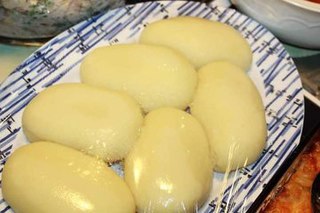
Fufu is a swallow found in West African cuisine. In addition to Ghana, it is also found in Sierra Leone, Guinea, Liberia, Cote D'Ivoire, Benin, Togo, Nigeria, Cameroon, the Democratic Republic of Congo, the Central African Republic, the Republic of Congo, Angola and Gabon. It is often made in the traditional Ghanaian, Ivorian, Liberian, and Cuban method of separately mixing and pounding equal portions of boiled cassava with green plantain or cocoyam, or by mixing cassava/plantains or cocoyam flour with water and stirring it on a stove. Its thickness is then adjusted to personal preference, and it is eaten with broth-like soups. Some countries, particularly the Igbo tribe in Nigeria, have a version of fufu (Akpu) made from fermented cassava dough that is eaten with thick textured stews. Other flours, such as semolina, maize flour, or mashed plantains, may take the place of cassava flour. Fufu is traditionally eaten with the fingers, and a small ball of it can be dipped into an accompanying soup or sauce.

Ẹ̀bà or Pinon is a staple swallow food mainly eaten in the West African sub-region and other African countries. The term èbà originates from the Yoruba people of southwest Nigeria. It is a cooked starchy vegetable food made from dried grated cassava (manioc) flour commonly known as garri. It is often eaten with rich soups and stews, with beef, stockfish or mutton. The dish is often described as having a slightly sour, sharp taste.

Ugali or posho or sima is a type of maize swallow made from maize or corn flour in several countries in Africa. Sima is sometimes made from other flours, such as millet or sorghum flour, and is sometimes mixed with cassava flour. It is cooked in boiling water or milk until it reaches a stiff or firm dough-like consistency. In 2017, the dish was added to the UNESCO Representative List of the Intangible Cultural Heritage of Humanity, one of a few foods in the list.
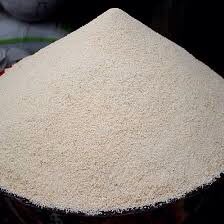
In West Africa, garri is the flour of the fresh starchy cassava root.
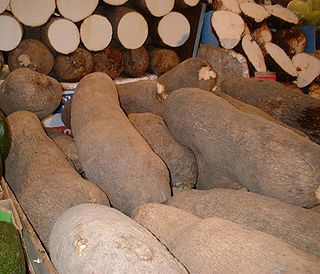
Yam is the common name for some plant species in the genus Dioscorea that form edible tubers. Yams are perennial herbaceous vines cultivated for the consumption of their starchy tubers in many temperate and tropical regions, especially in West Africa, South America and the Caribbean, Asia, and Oceania. The tubers themselves, also called "yams", come in a variety of forms owing to numerous cultivars and related species.

Àmàlà is a staple swallow food native to the Yoruba ethnic group of Southwestern Nigeria. It is made of yam, cassava flour, or unripe plantain flour. Tubers of yams are peeled, sliced, cleaned, dried and then ground into flour. It is also called èlùbọ́. Yams are white in colour but turn brown when dried which gives àmàlà its colour. It is a popular side dish served with ewédú and gbẹ̀gìrì, but is also served with a variety of other ọbẹ (soups), such as ẹ̀fọ́, ilá, and ogbono.

The cuisine of the Democratic Republic of the Congo and the Republic of the Congo varies widely, representing the food of indigenous people. Cassava, fufu, rice, plantain and potatoes are generally the staple foods eaten with other side dishes.

Ghanaian cuisine is the cuisine of the Ghanaian people. Ghanaian main dishes are organized around a starchy staple food, which goes with a sauce or soup containing a protein source. The main ingredients for the vast majority of soups and stews are tomatoes, hot peppers and onions. As a result, most of the Ghanaian soups and stews are red or orange in appearance.

West African cuisine encompasses a diverse range of foods that are split between its 16 countries. In West Africa, many families grow and raise their own food, and within each there is a division of labor. Indigenous foods consist of a number of plant species and animals, and are important to those whose lifestyle depends on farming and hunting.

Nigerian cuisine consists of dishes or food items from the hundreds of ethnic groups that comprise Nigeria. Like other West African cuisines, it uses spices and herbs with palm or groundnut oil to create deeply flavored sauces and soups.

A great variety of cassava-based dishes are consumed in the regions where cassava is cultivated, and the ingredient is included many national or ethnic specialities.

Central African cuisine includes the cuisines, cooking traditions, practices, ingredients and foods of the Central African Republic (CAR). Indigenous agriculture in the country includes millet, sorgum, banana, yam, okra, yellow onion, garlic, spinach, rice and palm oil. Imported crops of American origin include maize, manioc (cassava), peanuts, chili peppers, sweet potato and tomato. Additional foods include onions, garlic, chiles and peanuts.

Peanut soup or groundnut soup is a soup made from peanuts, often with various other ingredients. It is a staple of African cuisine but is also eaten in East Asia (Taiwan), the United States and other areas around the world. It is also common in some regions, such as Argentina northwest, Bolivia and Peru, where it can sometimes be served with bone meat and hollow short pasta or fries. In Ghana it is often eaten with fufu or omo tuo and is often very spicy. Groundnut soup is also a native soup of the Benin (Edo) people in Nigeria and it is often eaten with pounded yam. Some of the essential ingredients used in making it are Piper guineense and Vernonia amygdalina.
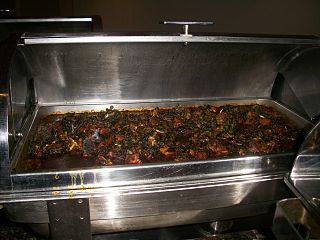
Edikang ikong is a vegetable soup that originated among the Efik people of Cross River State and Akwa Ibom State in Southeastern Nigeria. It is considered to be a delicacy among some Nigerians, and is sometimes served during occasions of importance. Edikang ikong is a nutritious soup and expensive to prepare, and has been described as being mostly eaten by rich people in Nigeria. Ingredients used in edikang ikong include beef and dried fish, bush meat, crayfish, shaki, kanda, pumpkin leaves, water leaves, ugu, onion, periwinkle, palm oil, salt and pepper.
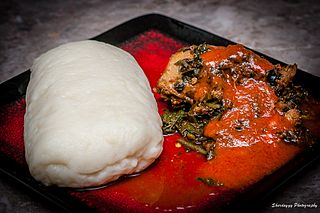
Pounded yam or Iyán (Yoruba) is a Nigerian swallow food native to the Yoruba, Igbo, Ebira and Tiv ethnic groups. It is a traditional food. It is prepared by pounding boiled yam with a mortar and pestle. Pounded yam is similar to mashed potatoes but heavier. It is a smooth and tasty delicacy traditionally eaten with the hands.
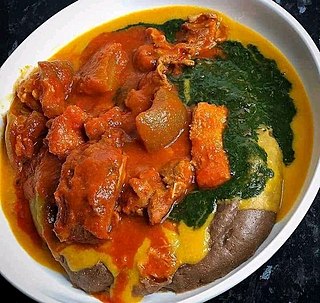
Ewedu soup is a soup created by the Yoruba ethnic group similar to Okra soup, it is made from jute leaf, hence it is known as jute leaf soup. The soup is drawy in texture and goes with Nigerian beef stew and fish stew. Ewedu soup takes about 12 minutes to prepare and is best served with pounded yam, fufu and Amala. Pluck jute leaf rinse with water and blend, then add crayfish, locust bean also known as iru and salt to give it desired taste. Ensure you do not add too much water, also you can ignore the use ijabe used to pound and kaun (potash) since you are using a blender.
Eka soup also known as ekuku is a delicacy of three tribes in the Eastern region of Nigeria, it is prepared from mashed palm kernel, roasted groundnut and benne seeds. Eka soup is best taken with starchy foods such as fufu.
Pawpaw soup is a popular delicacy of one of the Tiv ethnic group of Nigeria, the soup is made up of dry pawpaw flakes, palm oil, beef and egusi.
Ofe Owerri is an Igbo delicacy in the South-Eastern part of Nigeria. The soup is made with snails, beef,assorted meat and fishes.

Swallows are a category of dough-like African staple food made of cooked starchy vegetables and/or grains. Fufu of Western Africa, ugali and nsima of Eastern Africa, and sadza of Southern Africa are examples of swallows.

















